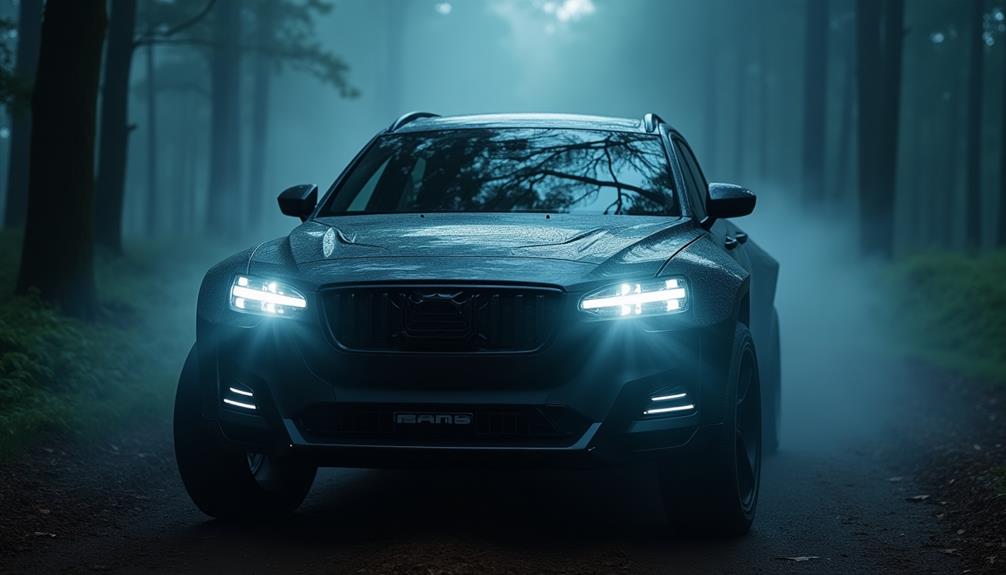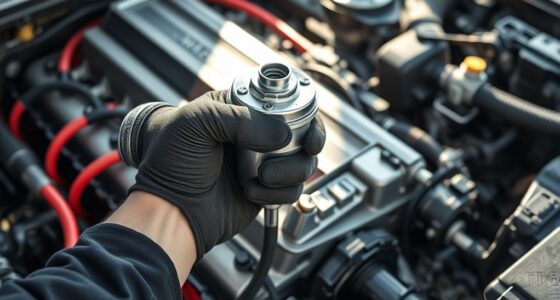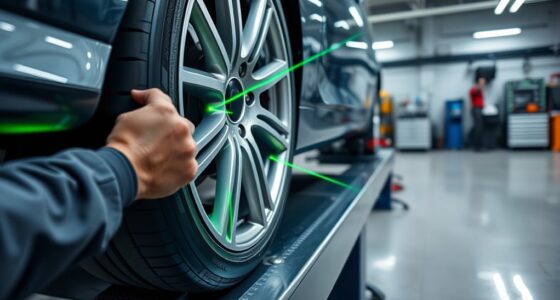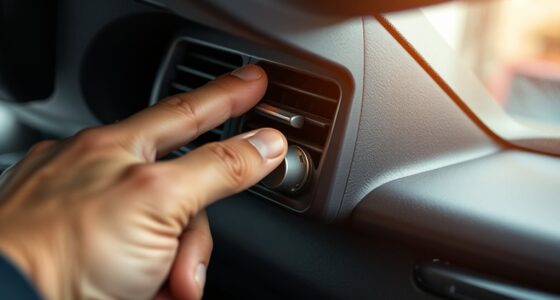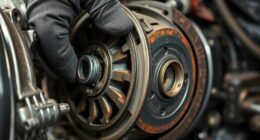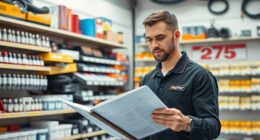If your AC isn't blowing cold air, a quick five-minute fix might just do the trick. First, check your thermostat settings to verify it's in "cool" mode and set lower than the room temperature. Then, inspect the circuit breaker to confirm it's in the "on" position; a simple reset can work wonders. Don't forget to clear any obstructions around your vents, as clogged filters can greatly reduce cooling efficiency. By addressing these quick fixes, you'll likely restore your AC's performance. There's more to explore if you're aiming for long-term cooling solutions.
Key Takeaways
- Check and adjust the thermostat settings to ensure it's set to "cool" and lower than the current room temperature.
- Inspect and replace clogged air filters to enhance airflow and improve cooling efficiency.
- Verify that the circuit breaker for the AC unit is in the "on" position and reset if tripped.
- Ensure all vents and registers are clear of obstructions to allow proper airflow throughout the space.
- Examine the disconnect switch for any visible damage and confirm it is in the "on" position.
Understanding AC Functionality

Understanding how your air conditioning system works is crucial for maintaining a comfortable indoor environment. When your AC isn't cooling, it's important to recognize that the system operates by extracting heat from indoor air and transferring it outside. This is done using a refrigerant, which absorbs and expels heat energy by changing from liquid to vapor.
The cooling process starts when warm air enters through the return vent. As it gets filtered, it's blown over the evaporator coil, where the refrigerant absorbs heat, cooling the air. The compressor then raises the refrigerant's temperature, allowing it to release heat outdoors via the condenser.
This cycle continues, recirculating cooled air back into your living space. Proper functionality hinges on efficient heat transfer. Issues like clogged filters, dirty coils, or low refrigerant levels can disrupt this process and lead to your AC not cooling effectively.
To maintain a comfortable environment, keep these components clean and well-maintained. By understanding the functionality of your AC system, you can better troubleshoot and address potential problems, keeping your home cool and comfortable all summer long.
Common Cooling Issues

When your AC isn't cooling properly, it's often due to common issues that can easily be overlooked. Identifying these problems can save you time and money. Here's a quick breakdown:
| Problem | Description |
|---|---|
| Clogged Filters | They restrict airflow, reducing cooling efficiency and forcing your unit to work harder. |
| Dirty Evaporator Coil | A filthy coil prevents effective heat absorption, leading to insufficient cooling. |
| Low Refrigerant | Often due to leaks, this results in warm air from vents and ice buildup on coils. |
Additionally, a malfunctioning compressor can hinder refrigerant heat transfer, contributing to inadequate cooling. Regular maintenance is essential; cleaning or replacing filters and inspecting the evaporator coil can greatly enhance airflow and cooling efficiency. Neglecting these common cooling problems can lead to system shutdowns and costly repairs.
Taking the time to address these issues will improve your AC's performance and extend its lifespan, ensuring you stay cool when it matters most. Don't wait for a breakdown—make these checks part of your routine!
Quick Fix: Check Thermostat
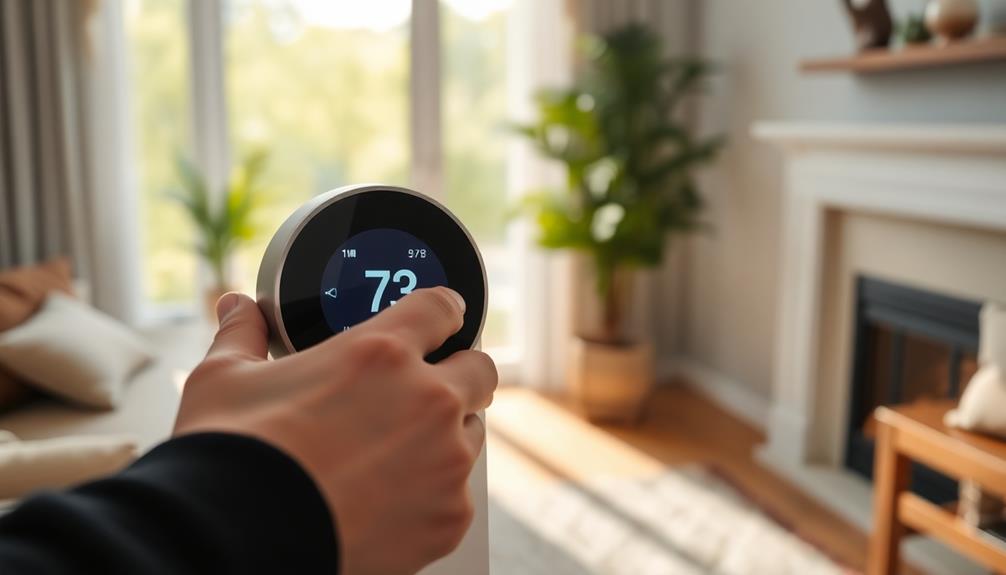
Checking your thermostat is a quick and effective way to troubleshoot why your AC isn't cooling. First, make certain your thermostat is set to "cool" mode and that the temperature is set lower than the current room temperature. If the display isn't lit, there may be a malfunction—check the batteries or power supply.
Next, clear any dust or debris from inside the thermostat. A clean thermostat guarantees it accurately reads the room temperature, which is vital for effective cooling.
If you're still having issues, inspect the wiring and connections at the thermostat. Make certain everything is secure and free from corrosion, as faulty wiring can prevent your AC from operating properly.
Regularly testing your thermostat's functionality can help you catch any calibration issues early. If it's not reading temperatures accurately, it may lead to inefficient cooling.
Inspect Circuit Breaker

If your thermostat checks out but your AC still isn't cooling, it's time to inspect the circuit breaker. This step is vital because the circuit breaker protects your AC unit from electrical overload. A tripped breaker can interrupt the power supply, preventing effective cooling.
Here's a quick checklist to guide you:
| Step | Action | Notes |
|---|---|---|
| 1. Check Breaker | Verify the breaker is in the "on" position. | A simple reset can restore functionality. |
| 2. Reset Breaker | If tripped, flip the switch off, then back on. | This may resolve cooling issues. |
| 3. Monitor AC Unit | Observe the AC unit's performance post-reset. | Confirm it's running smoothly. |
| 4. Inspect Wiring | Look for loose wires or faulty components. | Frequent tripping indicates underlying electrical issues. |
Regularly inspecting the circuit breaker and its wiring can prevent unexpected breakdowns and maintain consistent cooling performance. By taking these simple steps, you can effectively monitor the AC unit, guaranteeing it works efficiently and keeps you cool when you need it most.
Clear Airflow Obstructions
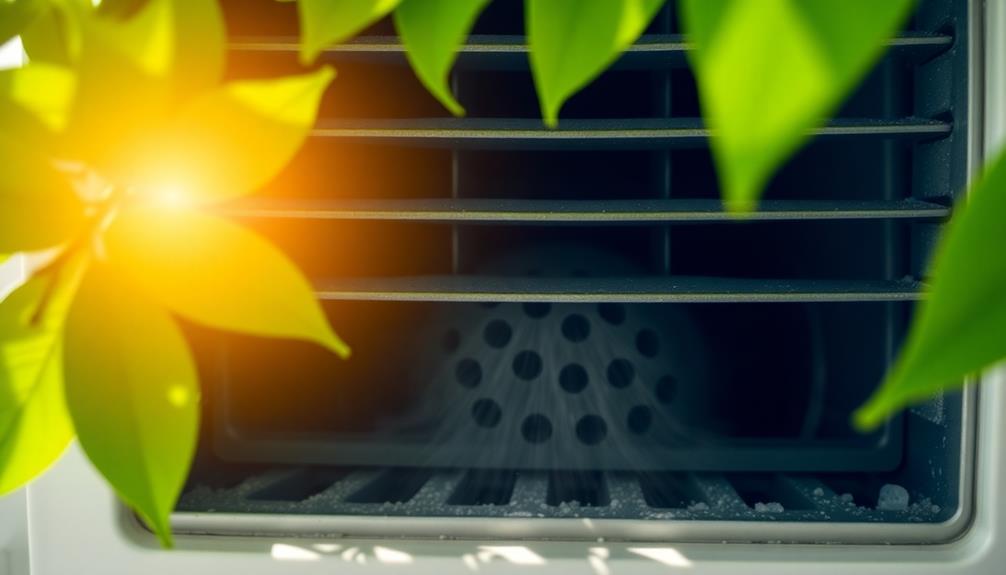
To keep your AC running efficiently, it's vital to clear any airflow obstructions that might be hindering performance. When air flow is restricted, the system struggles, leading to reduced cooling efficiency.
Here are three key areas to focus on:
- Dirty Air Filters: Regularly check and change your air filters every 1-3 months. Dirty filters restrict airflow, making it harder for your AC to operate effectively.
- Obstructed Vents: Verify all vents and registers are open and free from furniture or debris. Proper airflow is essential for ideal air circulation throughout your home.
- Ductwork Inspection: Inspect your ductwork for leaks or blockages. Sealing any gaps can greatly improve AC performance and enhance ventilation.
Additionally, keep the area around your indoor AC unit clear to allow effective air intake and prevent overheating.
Don't forget to clean your outdoor condenser unit by removing leaves and dirt to maintain proper airflow and heat exchange efficiency.
Verify Power Supply
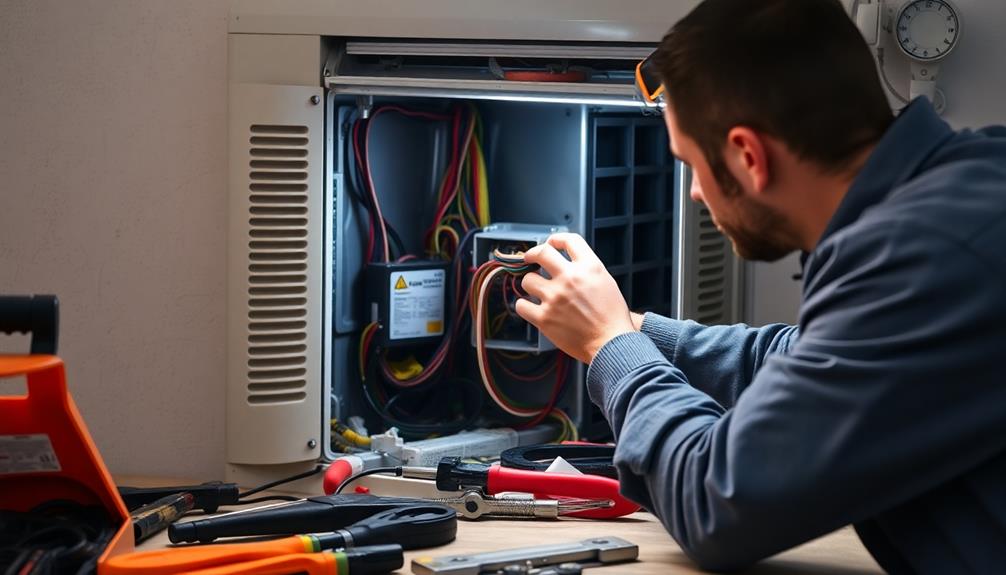
Before assuming there's a major issue with your AC, check the power supply.
Start by inspecting the circuit breaker status, the condition of the power cord, and the operation of the disconnect switch.
These simple checks can often reveal the source of your cooling problems.
Check Circuit Breaker Status
Have you checked the circuit breaker status lately? Your AC units rely on a steady power supply, and any disruption can lead to poor cooling performance.
Start by ensuring that both the indoor and outdoor unit circuit breakers are in the "on" position. If the breaker has tripped, a quick resetting can usually restore power. However, frequent trips might indicate deeper electrical issues that require a professional's attention.
Here's what to check:
- Circuit Breaker Position: Confirm that the circuit breaker hasn't tripped due to overload or short circuits.
- Inspect the Disconnect Box: Look for loose or damaged wires near the outdoor condenser unit, as these can impede power supply.
- Overall Electrical System: Verify that all switches are turned on and check for any blown fuses or damaged connections.
Inspect Power Cord Condition
A thorough inspection of the power cord can prevent frustrating AC issues. Start by checking for any visible damages like frays or cuts on the power cord, as these can disrupt the electricity flow to your AC unit. Next, verify that the power cord is securely plugged into the outlet; a loose connection can stop your unit from receiving power entirely.
To verify the outlet's functionality, plug in a different device and see if it works. If that device doesn't power on, you may have a problem with the power supply. Also, check your circuit breakers for any that might have tripped. If you find one, resetting it could restore power to your AC unit.
Here's a quick checklist to guide you:
| Action | Status |
|---|---|
| Inspect power cord for visible damages | [ ] Damaged [ ] Fine |
| Verify cord's securely plugged | [ ] Loose [ ] Secure |
| Test outlet with another device | [ ] Not Working [ ] Working |
| Check circuit breakers | [ ] Tripped [ ] Reset |
| Consult a qualified electrician | [ ] Needed [ ] Not Needed |
If you notice any issues, don't hesitate to consult a qualified electrician for safe repairs.
Verify Disconnect Switch Operation
After confirming the power cord is in good condition, the next step is to verify the operation of the disconnect switch. This switch, typically located near the outdoor condenser unit, is essential for cutting off power to the AC system during maintenance. If your AC isn't cooling, check that the disconnect switch is set to "on" and that the power supply is active.
Follow these steps to verify functionality:
- Inspect for Damage: Look for any visible signs of wear or loose wires in the disconnect box. Damaged components can impede the electrical flow necessary for your AC unit to operate efficiently.
- Check the Switch Position: Confirm the disconnect switch is in the "on" position. If it's tripped, reset it by turning it off and back on.
- Conduct Regular Maintenance: Make confirming the disconnect switch a part of your routine maintenance to prevent unexpected cooling failures.
Maintenance Tips for Efficiency

To keep your AC running efficiently, regularly replace or clean the air filters every 1-3 months.
Don't forget to schedule annual inspections to catch any potential issues early.
Also, make sure to clear any debris from the outdoor condenser unit to improve heat release and cooling performance.
Regular Filter Replacement
Keeping your air conditioning system running efficiently hinges on regular filter replacement. Dirty filters can block airflow, markedly reducing cooling efficiency and forcing your AC unit to work harder. This not only leads to higher energy bills but can also cause damage to internal components over time.
Additionally, understanding the impact of energy consumption on your overall utility costs can help motivate timely maintenance actions, as energy efficiency ratings provide benchmarks for comparison.
To maintain peak performance, follow these essential tips:
- Change or clean filters every 1-3 months: Regular filter replacement is vital, especially during peak usage seasons like summer.
- Monitor filter cleanliness with smart thermostats: These devices can remind you when it's time for a replacement, helping to guarantee consistent airflow.
- Inspect filters monthly: During high-demand periods, checking your filters monthly can prevent a buildup of dust and debris, allowing your AC unit to operate efficiently.
Annual System Inspections
Scheduling annual system inspections is essential for maintaining your air conditioning unit's efficiency and longevity. These inspections help you identify and resolve potential issues before they escalate, ensuring your AC operates smoothly throughout the cooling season.
Regular maintenance is particularly important as it can greatly enhance air quality and comfort in your space, aligning with goals of sustainability through energy-efficient technology like energy-efficient heat pumps. During these visits, HVAC professionals clean vital components like evaporator coils and condenser coils, which can enhance cooling performance by up to 30%.
Regular HVAC maintenance checks also include verifying refrigerant levels. Keeping proper refrigerant levels is vital; low levels can severely hinder cooling efficiency and may lead to costly compressor damage.
Additionally, inspections involve checking and replacing air filters. You should replace these every 1-3 months, as dirty filters can restrict airflow, reducing system efficiency by 15% or more.
Clear Condenser Unit Debris
A clean outdoor condenser unit plays an important role in your air conditioning system's efficiency. When you clear condenser unit debris, you guarantee maximum airflow, which is vital for maintaining cooling efficiency.
This is especially important as regular maintenance can prevent efficiency losses due to wear and tear and help avoid costly repairs down the line. Here are three steps you can take to boost your unit's performance:
- Maintain Clearance: Keep at least 2 feet of space around your condenser unit. This prevents obstructions that can limit airflow.
- Regular Cleaning: Aim for cleaning the condenser coils at least once a year. Use a garden hose to gently rinse and remove debris, but make sure you turn off the power first.
- Seek Professional Help: If you notice severe blockages, consider professional cleaning. Excess dirt can impair performance and lead to costly system failures.
For peak performance, understanding the refrigeration cycle is key to effective maintenance.
Troubleshooting Clogged Filters
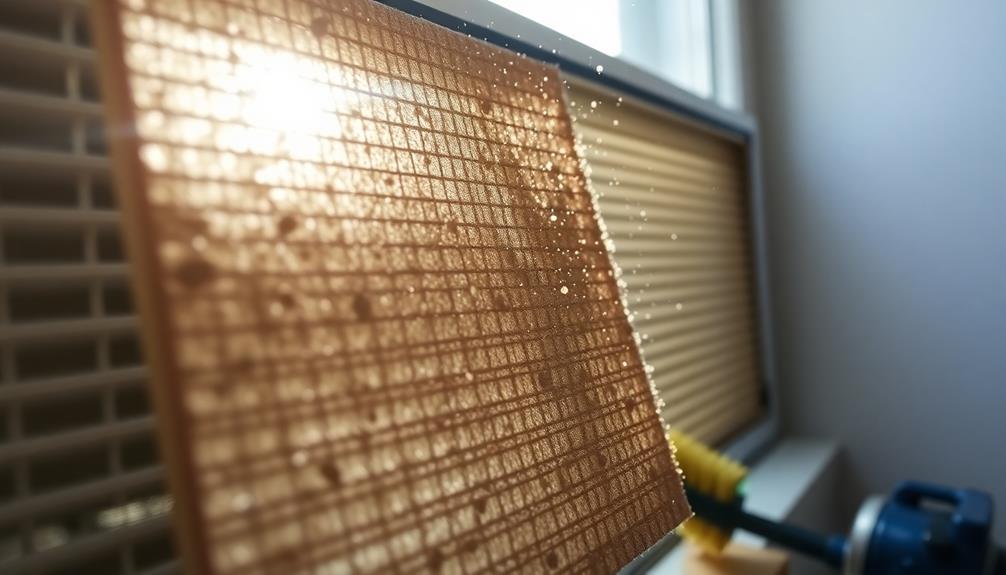
Regularly checking your air filters is essential for maintaining your AC's efficiency and cooling performance. Clogged air filters can severely restrict airflow, which leads to inadequate cooling and forces your AC system to work harder. This not only increases your energy bills but can also cause mechanical failures down the line.
Here's a quick guide to help you troubleshoot clogged filters:
| Issue | Symptoms | Action |
|---|---|---|
| Clogged Air Filters | Reduced airflow and cooling | Replace or clean |
| Dirty Filters | Increased energy bills | Check every 1-3 months |
| Frozen Evaporator Coils | Ice buildup on coils | Inspect filters |
| Smart Thermostat Alert | Filter cleanliness notifications | Follow alerts |
| Inefficient AC System | Constantly running, poor cooling | Clean or replace |
Preventing Ice Build-Up
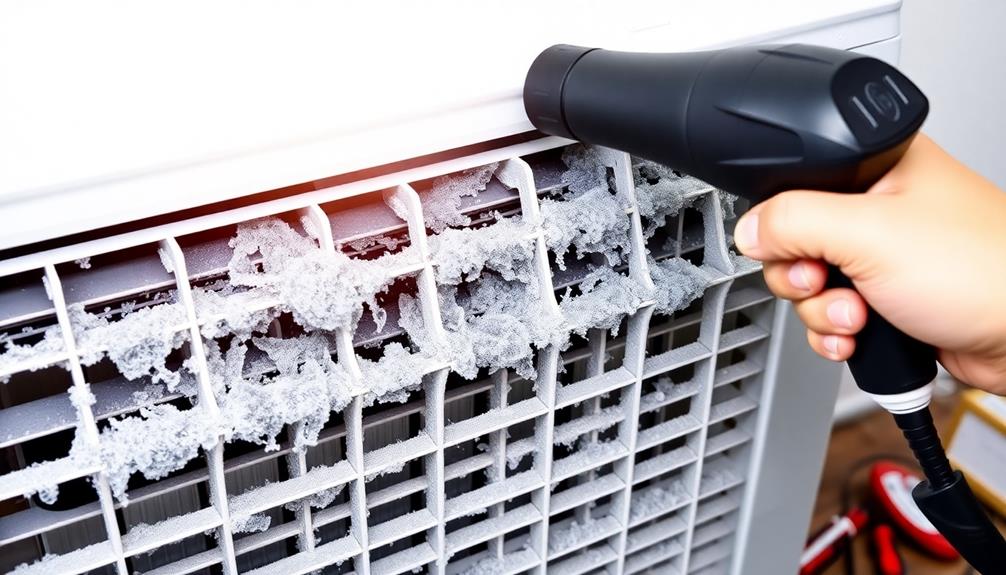
Preventing ice build-up in your AC system is vital for maintaining ideal cooling performance. Ice can hinder airflow, reduce cooling efficiency, and lead to costly repairs. Here are three key steps you can take to avoid this problem:
- Check Air Filters: Regularly change or clean your air filters. Clogged filters restrict airflow, causing the evaporator coils to freeze due to inadequate heat absorption.
- Clear the Condensate Drain Line: Make sure your condensate drain line is clear and functioning properly. Blockages can lead to water backing up, which may freeze around the evaporator coil.
- Monitor Refrigerant Levels: Keep an eye on your refrigerant levels. Low refrigerant can result from leaks, leading to poor heat absorption and potential ice build-up.
Additionally, confirm that all vents are unobstructed for consistent airflow.
Scheduling regular professional maintenance is vital, as technicians can inspect and clean your HVAC system's evaporator and condenser coils.
When to Call a Professional
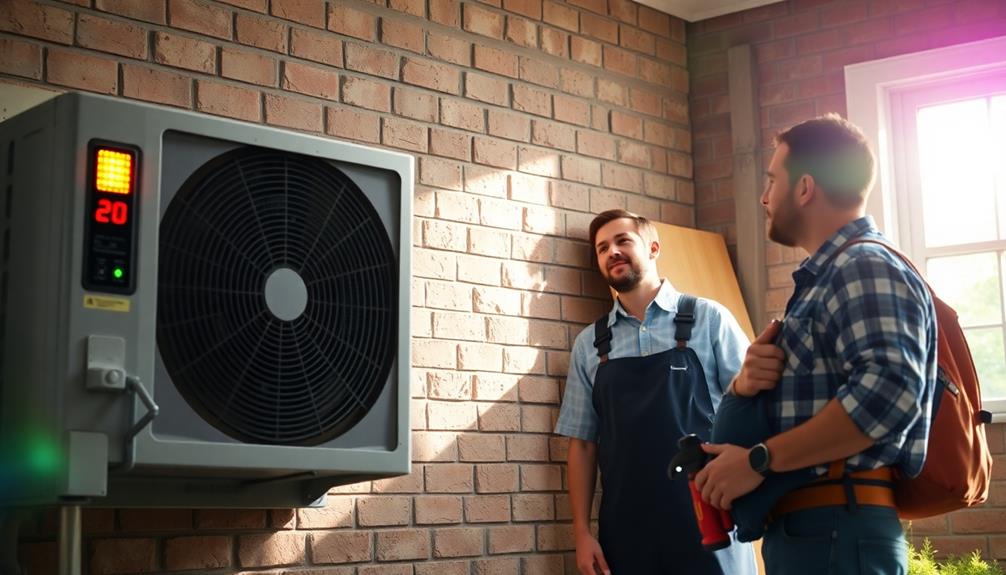
If you're still facing cooling issues after trying basic fixes, it might be time to call in a professional.
Persistent problems like warm air from the vents, tripped breakers, or strange sounds can indicate electrical issues or major component failures.
Don't hesitate to reach out for expert help when you suspect something more serious is going on.
Persistent Cooling Problems
Persistent cooling problems can be frustrating, especially when your AC unit fails to deliver the relief you expect. If you've tried basic fixes but your AC isn't cooling, it's time to contemplate professional intervention.
Here are three key indicators that suggest you should call an expert:
- Refrigerant Leak or Compressor Malfunction: If your unit blows warm air consistently, these issues could be the culprit.
- Ductwork or HVAC Sizing Problems: Uneven temperatures throughout your home may point to insufficient HVAC sizing or ductwork issues that require expert assessment.
- Mechanical Failures: Unusual noises, like grinding or buzzing, or failure to start often signal mechanical failures that need immediate attention.
If you face recurring issues after changing filters or cleaning coils, don't hesitate to reach out to a professional.
Additionally, if your AC unit is over 10-15 years old and shows inefficiency, it might be time to contemplate replacing your air system altogether. A qualified technician can evaluate whether repairs or a replacement is the best course of action. Regular maintenance, such as changing your air filter, can help extend the lifespan of your unit and improve efficiency. It’s recommended to replace your air filter now, as a clogged filter can force your system to work harder, increasing energy consumption. Ultimately, if inefficiency persists despite these efforts, a new system may offer greater long-term savings and comfort.
Electrical Issues Detected
Electrical issues can be a major roadblock to your AC's performance, leaving you sweltering in the heat. If your AC unit frequently trips the circuit breaker, it's a sign that something's amiss. This could indicate faulty wiring or other underlying problems that need a professional evaluation.
Don't ignore flickering lights or persistent breaker trips, as these symptoms often suggest more serious electrical issues.
Start by inspecting the disconnect switch; a malfunction here can hinder power to the outdoor unit. If you find loose connections, try tightening them, but be cautious.
If the problems persist after basic troubleshooting, like resetting the circuit breaker, it's time to call in a licensed electrician. They can perform a thorough inspection and identify any hidden complications.
Major Component Failures
When your AC starts showing signs of major component failures, such as a malfunctioning compressor or a faulty capacitor, it's vital to act quickly. Delaying could lead to further damage and higher repair costs.
Here are three key signs that you need to call an HVAC professional:
- Unusual Noises: If you hear grinding, squealing, or banging sounds, it could indicate a failing AC compressor.
- Oil Leaks: Any visible oil around the unit could suggest internal issues, and you shouldn't ignore it.
- System Not Running: If your AC is unresponsive or you hear humming without it starting, you may have a broken capacitor.
Addressing these issues promptly can prevent more extensive repairs down the line. Neglecting a damaged motor or a frozen evaporator coil can worsen the situation.
Regular professional maintenance is also important, as it can help identify potential major component failures before they escalate.
Don't hesitate to reach out to an HVAC professional if you notice these signs; it's better to be safe than sorry when it comes to your comfort and the efficiency of your system.
Frequently Asked Questions
Why Does My AC Work but Not Cold Enough?
If your AC works but isn't cool enough, check the air filter, evaporator coil, and refrigerant levels. Verify the outdoor condenser is clean and that your thermostat settings are accurate to optimize cooling efficiency.
Why Is My AC Having a Hard Time Cooling?
Did you know that 75% of AC issues stem from dirty filters and coils? If your AC's struggling to cool, check the filter, clean the coils, and verify refrigerant levels are adequate for peak performance.
Why Does My AC Stop Cooling After 5 Minutes?
Your AC might stop cooling after five minutes due to a frozen evaporator coil, low refrigerant levels, a malfunctioning compressor, or electrical issues. Regular maintenance can prevent these problems and guarantee consistent cooling.
How Do I Reset My Central AC Not Blowing Cold Air?
To reset your central AC, turn off the thermostat, wait five minutes, then turn it back on. Also, check the circuit breaker and verify the thermostat's set to "cool" below the current temperature.
Conclusion
Just like a ship needs wind to sail smoothly, your AC relies on proper care to keep your home cool. By checking the thermostat, inspecting the circuit breaker, and clearing any obstructions, you can steer clear of common cooling issues. Regular maintenance acts as the compass guiding you towards efficiency. If you encounter turbulent waters, don't hesitate to call a professional. With these tips, you'll navigate the heat with ease and keep your comfort vessel afloat.

